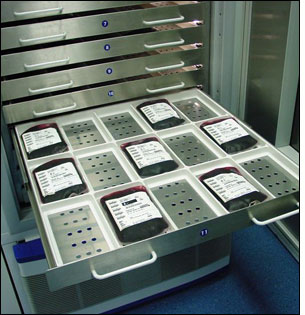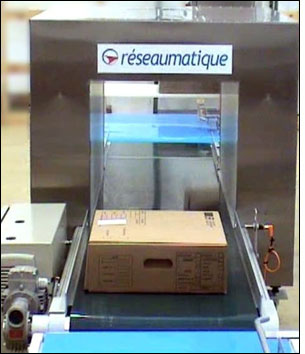Having completed two pilot projects testing an RFID solution for tracking blood products, the Etablissement Français du Sang (EFS), or French Blood Institution—which manages France’s blood-donor centers—has submitted the results of those pilots to a French regulatory agency that will now determine a protocol based on the safety of RFID technology in the presence of blood products. If the agency issues such a protocol, blood banks throughout that nation will be permitted to track their products with radio frequency identification rather than bar-coded labels, thereby enabling them to store more information about the products, as well as automate some processes.
EFS, which has been examining RFID technology for the past 10 years, conducted two pilots—one in 2007 and 2008, involving red blood cells, and a second in 2009 and 2010, testing RFID to track plasma through laboratories and manufacturing sites, as well as to a hospital. In addition to supplying custom-designed tags and readers for this application, Biolog-ID (formerly known as Réseaumatique) provided the software that managed data from RFID reads and sent that information to the enterprise resource planning (ERP) systems used by the pilots’ participants. The readers were designed to provide the reading and writing times required for the application, while the tags’ form factor was modified to transmit in the presence of liquids, with an adhesive that would provide further RF insulation between the tag and the blood products.

As a result of the pilots, says Gilles Folléa, EFS’ manager throughout the projects and now the executive director of the European Blood Alliance, EFS submitted a request for approval in February 2010 from the Agence Française de Sécurité Sanitaire des Produits de Santé (AFSSAPS), the French governmental agency responsible for overseeing the safety of health products, asking that organization to put in place an approved protocol that would allow the blood industry to track products using RFID. The establishment of such a protocol, he cautions, may take a year or more. “Modifying regulations is very sensitive, and requires careful assessment,” he explains. “It will take time, but it is very difficult to predict exactly how long.”
The 2007-2008 pilot included attaching passive 13.56 MHz RFID tags, compliant with the ISO 15693 standard, to a total of 700 to 800 bags of red blood cells at the ETS-Pays de Loire blood center, in Nantes, after they have been separated from plasma. The pilot’s objective, says François-Luc Monge, the commercial director of Biolog-ID’s health division, was to test the hardware, ensuring that tags could be read on the blood bags, and to test the interface between the RFID tag reads and the blood transfusion center’s back-end management system. The tags were encoded with a unique identifier, and as they were read, additional information was written to them. After a bag was filled with red blood cells, for example, a tag was attached to that bag, and a Biolog-ID desktop RFID interrogator read the tag’s ID number, while at the same time encoding the tag with the identification number of the blood donation, as well as a product code and the blood type. The tags were read once more before leaving the blood center, immediately before being shipped to the participating hospital, Polyclinique du Parc.
When the hospital received a box packed with red blood-cell bags, the box was unpacked and the tags were read again with another Biolog-ID desktop reader, plugged into a PC. With each read, the interrogator transmitted the ID number and product information to the back-end ERP system, in which the bag’s status would be updated to reflect its arrival at the hospital.
Employees then placed the bag in a drawer inside an RFID-enabled refrigerator called a Biolog-ID Smart Fridge. Each of the Smart Fridge’s 13 drawers was divided into 15 cells (each storing a single bag), and each cell was also equipped with a built-in RFID reader antenna (there were three readers installed in each drawer). The reader captured the blood bag’s ID number, as well as other details, and forwarded that data to the back-end system, indicating the bag was in refrigeration. On a regular basis, the Smart Fridge also sent its own temperature reading, based on measurements of a sensor within the fridge.
When the blood bag was removed, the reader no longer received transmissions from that tag, and the software updated that bag’s status to indicate it had been removed. The operator then placed the bag on the Biolog-ID desktop reader, in order to confirm that it matched the order listed on the computer, and checked the receiving patient’s blood type to ensure a match.

In the event of an emergency in which blood was needed immediately, Polyclinique du Parc’s staff could enter the software and locate bags matching the blood type of a patient requiring a transfusion, and could then retrieve those bags from their location within the smart fridge. Operators could also use the software to take inventory of the available blood products, in order to determine if specific types need to be reordered, without opening the refrigerator and manually reading the bags’ labels.
If the hospital needed to return a bag to the ETS-Pays de Loire blood center (if, for instance, the blood product had expired), the operator could conduct a search for a specific bag or type of bag in the software, determine where that bag was stored, and remove it. The bag was then read again on the desktop reader before being shipped back to the blood center. Temperature sensors within the refrigerator were used to measure the unit’s internal temperature, and readings taken every few minutes were stored in each bag’s records, thereby indicating how long it remained in the refrigerator, at what times and on which dates, and its temperature history.
The effectiveness of the hardware and software was impressive, Folléa says. “The outcome was perfect,” he states. “As a proof of concept, it was perfect—there were absolutely no mistakes [in RFID reads or data management].” However, he notes, the group wanted a second pilot to provide sufficient data to request protocol approval from the French regulatory authorities.
The second pilot, which took place in 2009, was launched at three laboratory/blood-center locations—in Nantes, Lille and Paris—and involved tagging products from plasma-derived medical products manufacturer LFB, located in Paris. In this case, several thousand bags were tagged.
“LFB wished to revise its means of production by automating, in particular, flows of raw material reception [plasma arriving from a blood center],” Monge says. When plasma was prepared for shipment from a blood center to LFB, each blood center affixed an RFID tag to the plasma bag. The blood donation ID number and product code were then encoded onto the tag and stored in the back-end LFB server, together with the tag’s unique identifier. When the bag was shipped to LFB, the bags were packed in cardboard boxes (25 bags per box), with an RFID tag attached to the box, linked to each bag tag’s ID number in the back-end software, as well as to data regarding that order. The tagged box, as well as all tags within that box, were read by a tunnel reader that Biolog-ID built specifically for the application, in order to validate the product code and compare it against the order.
LFB also used a similar tunnel reader to read the bag and box tags when a shipment was received, and employed another tunnel reader on a “screening line” to enable a final validation of the product before it was moved into production at the LFB facility. During the production process, the plasma derivatives from that product were removed and placed into additional bags, which were then shipped to hospitals. These bags were not tagged, but further pilots may include tracking the blood products to patients.
“Results [of the pilots] are extremely encouraging,” Monge states, “and the return of experience from the different actors was very positive.”
According to Folléa, EFS’ emphasis in carrying out the pilots was to have AFSSAPS develop a protocol (usage guideline to ensure the safety of the blood product in the presence of RFID) for a system that would allow the storage and easy access of more information about each bag of a blood product—which, he says, will increase safety in the blood supply chain by making data such as blood types and expiration dates readily available. EFS is not currently undertaking any additional RFID pilots.


